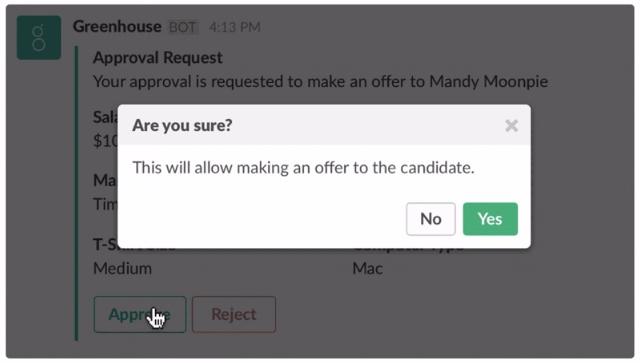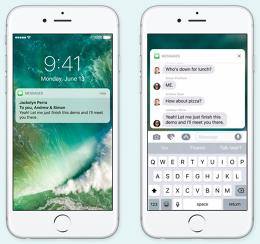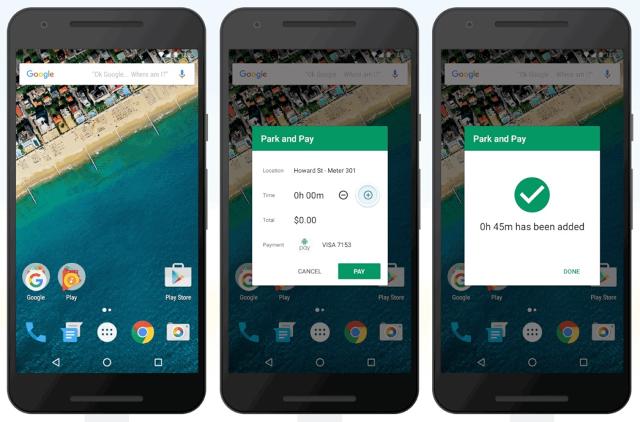You Need Full-Blown Apps Less Than Ever, And Slack’s New Buttons Prove It
Earlier this week, Slack made a big change to how its third-party app integrations work. Instead of making users type out specific commands, Slack apps can now offer a set of buttons for taking immediate action.
Some examples: Users can approve or deny expense reports from Abacus, assign due dates in Trello, or pay a coworker back for lunch with Current—all with one click from a Slack chat. The hope is that workers will spend less time bouncing between applications, and will instead just stay inside Slack to accomplish simple tasks.
This concept extends far beyond Slack, however, and is really part of a broader trend in which apps largely exist outside of themselves. Slack buttons bring us a just little closer to a scenario where downloading apps becomes unnecessary, and your favorite services never take up a spot on your home screen or desktop.

Blurring App Boundaries
With its new Message Buttons, Slack is taking a page from the chatbots on other, more consumer-oriented messaging services such as Facebook, Kik, and WeChat. While the hype around chatbots can sometimes get excessive, ultimately they’re just a new way to access apps, repurposed for the chat windows where users are spending increasing amounts of time.
“Everyone has a phone in their pocket, everyone is used to messaging each other all day long,” says Buster Benson, a senior product manager at Slack. It makes sense, then, to provide tools for getting things done directly within that environment.
“Where the real work is just making a decision, or approving something, or tagging something—and that’s really the work that a lot of us do every day—that should happen in the interface that’s closest to us,” Benson says.
Although chatbots have become a phenomenon on their own, they’re ultimately just one of many app access points that have opened up beyond your home screen.
The trend began a few years ago with actionable notifications in Android (and later, iOS), which allowed you to delete emails, respond to text messages, and check off tasks without opening the full app. Those actionable notifications then spilled over to the lock screen, so you didn’t even have to unlock your phone to get things done. (Apple is expanding on this concept in the upcoming iOS 10, with lock screen cards that seem to replace much of an app’s core functionality.) And as virtual assistants like Siri open up to third-party apps, it’s getting easier to perform quick actions without even touching the screen.

What’s driving this shift? In large part, it’s the emphasis on APIs and extensibility as the centerpiece of modern software.
With the project management software Trello, for instance, the company built an API first, then built its own apps and website on top of it. The Trello website is just a client that takes advantage of those APIs, and in theory could be rebuilt by anyone, says Trello CEO Michael Pryor.
“From a technology standpoint, it’s a really awesome way to build an app nowadays, especially if you’re building something that you want to be a platform, because the API is so important in that process in opening it up to other people.”
By starting with the API, Trello can more easily adapt to new platforms like Slack. It’s also a platform unto itself, for example allowing users to attach Google Drive documents and Github links to their project overviews. There’s even a way to set Slack reminders directly through Trello.
“It’s the same playbook, essentially,” Pryor says. “If you’re going to build an app, you have to play in this ecosystem of all the other apps, and how you’re connecting them.”
Demoting The App Launcher
If every app is just grafting its functions onto other apps and services, it’s natural to wonder what it means to be an app anymore. Are we headed for a future where the notion of installing software and launching it from a home screen becomes largely unnecessary?
Slack is approaching the question with caution. While building its buttons, there were lots of requests from developers to add more functionality, including extra buttons, drop-down lists, and text entry. Although Slack decided to start with the bare minimum, it’s not hard to imagine some apps becoming entirely self-contained within a chat window.
“It’s a learning experience for us,” Benson says. “We’re building into the most core part of the Slack product—the message itself—so we don’t want to arbitrarily add things until we’re pretty certain that want them there forever.”
The point may become moot, however, as apps themselves start breaking down into smaller component parts, making them easier to access in any context.
Last month, Google announced Android Instant Apps, which will let users stream apps onto their phones with no installation required. A hotel-booking app, for instance, could link to its list of room openings from Google Search, and a parking app could let you pay just by tapping your phone against an NFC-enabled meter.

The main draw for app makers right now is the promise of another discovery mechanism outside of Google’s app store, says Dan Bachelder, the head of mobile for real estate-finding app Zumper, one of the Instant Apps that Google demonstrated at its I/O developer conference in May. But in the long run, app streaming could have deeper implications. Bachelder, for instance, imagines being able to instantly share part of an app with someone else, without making anyone first download the entire thing and find the appropriate sub-menu.
“Instant delivery and deep-linking into tasks is super-powerful, and something we’ve really been missing, and I’m super excited about it,” he says.
It’s the kind of scenario that easily translates to an app like Slack: Instead of relying solely on buttons to interact with Trello, you might be able to click a link that streams the project board in question. Regardless of whether you’ve installed Trello or not, you’d instantly be on the same page as everyone else in the room.
In this future, maybe you’ll still have an app launcher, at least for a handful of functions. But most of the time, you wouldn’t even think to use it.
Fast Company , Read Full Story
(11)


